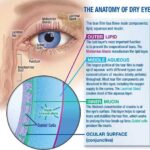Today I bring a small contribution entitled: Dry eye disease and its implications on visual function. I am an Optometry Student at the Specialized University of Americas in Panama city, Central America.
What is dry eye?
According to the report of the Definition and Classification Subcomité of the International Dry Eye WorkShop in 2007: We can define this ocular pathology as a multifactorial disease of the tears and ocular surface that causes symptoms of discomfort, visual disturbance and tear film instability with potential damage to the ocular surface. It iss accompanied by an increase in tear film osmolarity and ocular surface inflammation.
Dry Eye Symptoms:
People with dry eyes experience symptoms of irritated, gritty, scratchy, or burning eyes, a feeling of something in their eyes, excess watering, and blurred vision. Advanced dry eyes may damage the front surface of the eye and impair vision.
Influence of visual acuity on the visual functionality:
The inclusion of visual impairment in the definition of dry eye is due to the accumulating evidence that dry eye is actually associated with dynamic visual changes. As we all know the tear film has a refractive function which is affected in dry eye influencing the patient’s visual acuity.
Standard tests for measuring visual acuity are excellent in the study of visual functionality, however the contrast sensitivity test and the light sensitivity test provide information much more detailed in specific aspects of visual function. Recently, it has been reported that the measurement of functional visual acuity is an important method of defining “detailed visual function.” This method has proven effective in the detection of “occult lesion visual function” in dry eye patients who complained of decreased VA despite having normal results on tests of conventional VA.
It has been suggested that measurement of functional visual acuity is an important indicator of the ability of a subject in relation to certain daily activities such as driving, reading and computer work.
Currently, there are important studies in Japan looking for a more accurate way to evaluate functional visual acuity in patients with dry eye and determine what treatment would be most appropriate. In summary, the system of measuring visual acuity functionality is a new technology that seems to be only an effective tool to detect dynamic changes in the visual acuity in the dry eye, in the alterations of the ocular surface and in normal subjects. But also a promising method for evaluating the outcomes of management of dry eye.


